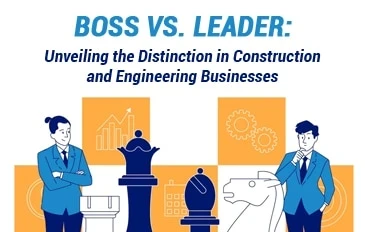Boss vs. Leader: Unveiling the Distinction in Construction and Engineering Businesses

Boss vs. Leader: Unveiling the Distinction in Construction and Engineering Businesses
In the construction and engineering industries, effective leadership is paramount to success. However, being a boss and being a leader are not interchangeable terms. This blog post aims to explore the fundamental differences between being a boss and being a leader within the context of construction and engineering businesses. We will delve into the qualities, approaches, and impacts of both roles to understand how they shape organizational culture, employee engagement, and overall project outcomes.
- Authority vs. Influence: A boss typically relies on their position of authority to exercise control and demand compliance. They use their formal power to make decisions, assign tasks, and enforce regulations. In contrast, a leader focuses on influence rather than authority. They earn the respect and trust of their team through their expertise, communication skills, and ability to inspire. Leaders lead by example and motivate their team members to achieve their best.
- Transactional vs. Transformational: A boss tends to employ a transactional leadership style, which centers around rewarding or punishing employees based on performance. They focus on meeting specific targets and enforcing rules to maintain discipline. On the other hand, a leader adopts a transformational leadership style, inspiring and empowering their team members to grow, innovate, and excel. They foster a collaborative environment that encourages personal and professional development.
- Task-Oriented vs. People-Oriented: Bosses are typically task-oriented, prioritizing productivity and efficiency. They may overlook the individual needs, motivations, and well-being of their team members. Leaders, on the other hand, are people-oriented. They invest time and effort in understanding their employees, providing guidance, mentorship, and support. Leaders value the unique strengths of their team members and align their roles with individual capabilities for optimal performance.
- Short-Term vs. Long-Term Focus: A boss often focuses on short-term goals and immediate results. Their decision-making revolves around meeting deadlines and achieving immediate objectives, sometimes overlooking the long-term consequences. In contrast, leaders take a more strategic approach, considering the long-term impact of their decisions. They envision the future, set clear goals, and inspire their team to work towards a shared vision of success.
- Control vs. Empowerment: Bosses typically maintain tight control over their team members, dictating the how, when, and what of tasks. They have a top-down approach, stifling creativity and autonomy. Conversely, leaders believe in empowering their team members. They delegate responsibilities, encourage innovation, and trust their employees to make informed decisions. Leaders create an environment that fosters ownership, collaboration, and continuous improvement.
- Impact on Organizational Culture: The leadership style employed within construction and engineering businesses significantly impacts the organizational culture. A boss-driven culture may breed fear, resentment, and disengagement among employees. It can result in high turnover rates and limited employee loyalty. In contrast, a leader-driven culture fosters trust, open communication, and a sense of belonging. It encourages employee growth, job satisfaction, and loyalty, ultimately leading to increased productivity and innovation.
In conclusion: the construction and engineering industries, being a boss is not synonymous with being a leader. While a boss relies on authority and transactional relationships, a leader inspires through influence and transformation. The distinction between the two lies in their approaches to authority, communication, employee empowerment, and long-term vision. By embracing leadership qualities and adopting a transformational style, construction and engineering professionals can create an environment that fosters growth, collaboration, and exceptional project outcomes.
Michael DeSafey is a leading executive recruiter for professionals in the construction, engineering, and environmental industries. He is currently the President of Webuild Staffing: www.webuildstaffing.com. To learn more about Michael, or to follow his blog, please visit www.michaeldesafey.com.
Category: Career Training, Construction, Employer Tips, Jobs, Recruiting
